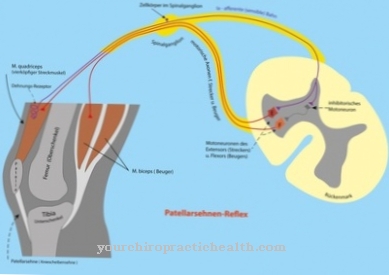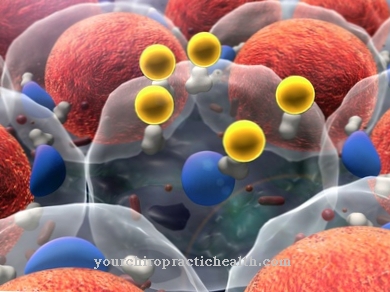The Signal transduction is the transmission of external and internal stimuli in the organism. Mainly receptor proteins, messenger substances and enzymes are involved in this signal transmission. Errors in signal transduction underlie most diseases, such as cancer and autoimmune diseases.
What is signal transduction?

Body cells react to external and internal stimuli by means of physiological signal transduction or signal transmission. During this process, a signal is converted and penetrates inside a cell, where it triggers the cellular effect through a signal chain. In this way, signals can be transmitted from one body compartment to another. Cells are thus able to communicate with one another.
The signal transmission takes place either on one or on several levels. If several levels connected in series are involved in the process, we speak of a signal cascade. Enzymes and secondary messenger substances are involved in signal transduction. We are therefore often talking about an enzymatically mediated, biochemical process in which biological information is passed on via carrier substances.
The signals from different sources are coordinated with one another in the cytoplasm or cell nucleus. The different signal paths of a cell type together form what is known as the signal network.
Immune reactions and muscle contractions as well as visual and olfactory perceptions are dependent on signal transduction.
Function & task
There are proteins on the cell membrane and inside a body cell. These proteins act as receptors. Signal molecules attach to receptor proteins on the surface. The receptors pick up signals from outside or inside and direct them into the cell for processing.
The best-known signal molecules include neurotransmitters and hormones, for example. There are many different receptors in the human body. For example, cystolic receptors are located in the viscous part of the cytoplasm. This type of receptor mainly includes the steroid receptors. The membrane-based receptors must be distinguished from these receptors. They have an intra- and an extracellular level. This enables them to bind signaling molecules outside the cell. In order to allow the signal to penetrate inside, they change their spatial structure.
The signal itself does not penetrate the cell. Instead, the signal information reaches the inside of the cell via biochemical processes of the proteins. These biochemical processes are controlled by hydrophilic substances such as neurotransmitters.
Membrane-related receptors are either ion channels, G-protein-coupled receptors or enzyme-coupled signaling pathways. Ion channels are transmembrane proteins. They are either activated or deactivated via a signal. The permeability of the membrane increases or decreases for certain ions. Ion channels are particularly relevant for nerve signals.
G protein-coupled receptors stimulate a G protein to replace bound GDP with the chemical compound GTP. The G-protein breaks down into the units α and βγ, which both transmit the signal. The G-protein-coupled receptors are involved in processes such as sight and smell.
Enzyme-coupled signaling pathways consist of six subclasses. All of them correspond to transmembrane proteins. Processes such as kinase-mediated phosphorylation and phosphatase-mediated dephosphorylation play a role in relation to these signaling pathways.
Regardless of the signal pathway, the transmission of internal and external signals to effector proteins inside the cell is the actual goal of signal transduction. This forwarding takes place via targeted interactions between several proteins. The activation of signal proteins and intracellular signal proteins plays a major role in this process. Some signals are amplified by activating several effector proteins at the same time.
Second messengers are particularly relevant for the networking of signal transduction pathways and the integration of various signals. These are interfaces of different pathways that can trigger cell-specific reactions.
Signal transduction enables a unicellular organism to adapt to its environment, for example by regulating changes in the system or by gene expression. Only then does the process enable the unicellular organisms to survive. In multicellular cells, signal transduction enables the reception and processing of internal and external stimuli. Signal transduction is also indispensable for their survival. Cell growth, cell division and cell death are influenced, for example, by the processes described.
Illnesses & ailments
When signal pathways are disrupted, this disorder can lead to various diseases. Cancer, diabetes, kidney disease and autoimmune diseases have been shown to be related to errors in signal transmission.
A signal molecule usually binds to one of the described receptors on the surface of a cell and can trigger cell division in a complex response. In cancer, mutations in the coding genes for signal substances, receptors or enzymes lead to increased or misdirected signaling pathway activity. This results in an increase in the stimulation of cell division. In this context, the enzymes involved in the transduction play a major role. They are often more active in cancer. Pharmacology therefore wants to selectively inhibit these enzymes in the future and thus develop a cancer drug.
Apart from anti-cancer drugs, medical research is currently (as of 2015) intensively concerned with the development of remedies based on signal transduction processes. Even cholera, whooping cough, and common ailments such as high blood pressure are linked to errors in signal transduction that are believed to be promoted by certain external stimuli.
The drugs available today for various diseases also intervene specifically in signal transduction. In the future, this procedure will probably be more targeted and targeted.
























.jpg)



